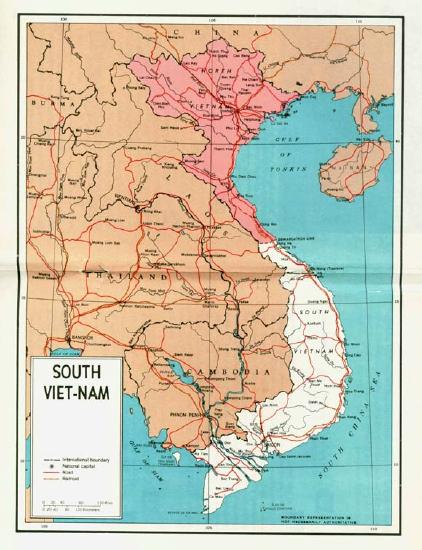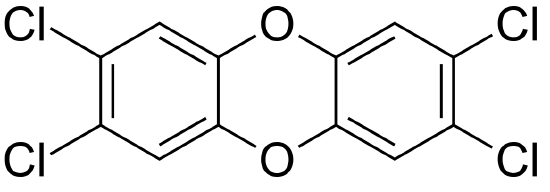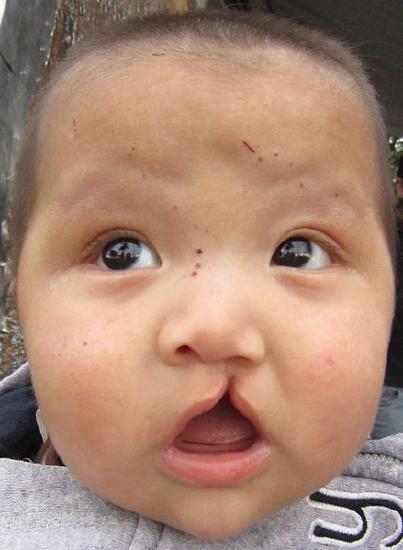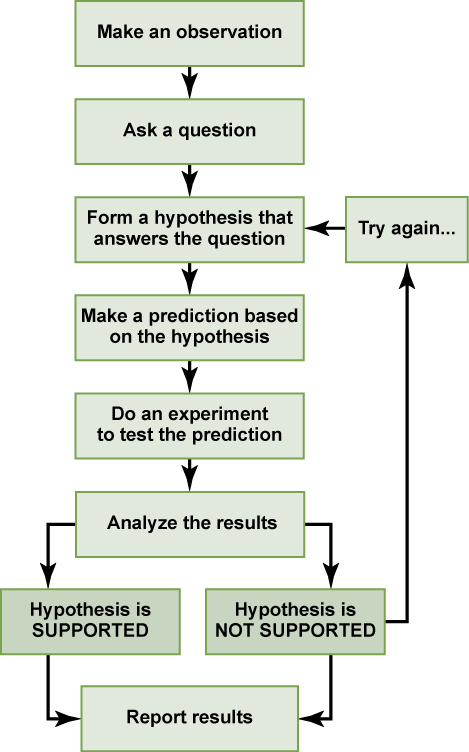2.1: The Scientific Method
- Page ID
- 94370
Hypothesis Testing and The scientific Method
The scientific method is a process of research with defined steps that include data collection and careful observation. The scientific method was used even in ancient times, but it was first documented by England’s Sir Francis Bacon (1561–1626) (Figure \(\PageIndex{5}\)), who set up inductive methods for scientific inquiry.

Observation
Scientific advances begin with observations. This involves noticing a pattern, either directly or indirectly from the literature. An example of a direct observation is noticing that there have been a lot of toads in your yard ever since you turned on the sprinklers, where as an indirect observation would be reading a scientific study reporting high densities of toads in urban areas with watered lawns.
During the Vietnam War (figure \(\PageIndex{6}\)), press reports from North Vietnam documented an increasing rate of birth defects. While this credibility of this information was initially questioned by the U.S., it evoked questions about what could be causing these birth defects. Furthermore, increased incidence of certain cancers and other diseases later emerged in Vietnam veterans who had returned to the U.S. This leads us to the next step of the scientific method, the question.

Figure \(\PageIndex{6}\): A map of Vietnam 1954-1975. Image from Bureau of Public Affairs U.S. Government Printing Office (public domain).
Question
The question step of the scientific method is simply asking, what explains the observed pattern? Multiple questions can stem from a single observation. Scientists and the public began to ask, what is causing the birth defects in Vietnam and diseases in Vietnam veterans? Could it be associated with the widespread military use of the herbicide Agent Orange to clear the forests (figure \(\PageIndex{7-8}\)), which helped identify enemies more easily?

Figure \(\PageIndex{7}\): Agent Orange drums in Vietnam. Image by U.S. Government (public domain).

Figure \(\PageIndex{8}\): A healthy mangrove forest (top), and another forest after application of Agent Orange. Image by unknown author (public domain).
Hypothesis and Prediction
The hypothesis is the expected answer to the question. The best hypotheses state the proposed direction of the effect (increases, decreases, etc.) and explain why the hypothesis could be true.
- OK hypothesis: Agent Orange influences rates of birth defects and disease.
- Better hypothesis: Agent Orange increases the incidence of birth defects and disease.
- Best hypothesis: Agent Orange increases the incidence of birth defects and disease because these health problems have been frequently reported by individuals exposed to this herbicide.
If two or more hypotheses meet this standard, the simpler one is preferred.
Predictions stem from the hypothesis. The prediction explains what results would support hypothesis. The prediction is more specific than the hypothesis because it references the details of the experiment. For example, "If Agent Orange causes health problems, then mice experimentally exposed to TCDD, a contaminant of Agent Orange, during development will have more frequent birth defects than control mice" (figure \(\PageIndex{9}\)).

Figure \(\PageIndex{9}\): The chemical structure of TCDD (2,3,7,8-tetrachlorodibenzo-p-dioxin), which is produced when synthesizing the chemicals in Agent Orange. It contaminates Agent Orange at low but harmful concentrations. Image by Emeldir (public domain).
Hypotheses and predictions must be testable to ensure that it is valid. For example, a hypothesis that depends on what a bear thinks is not testable, because it can never be known what a bear thinks. It should also be falsifiable, meaning that they have the capacity to be tested and demonstrated to be untrue. An example of an unfalsifiable hypothesis is “Botticelli’s Birth of Venus is beautiful.” There is no experiment that might show this statement to be false. To test a hypothesis, a researcher will conduct one or more experiments designed to eliminate one or more of the hypotheses. This is important. A hypothesis can be disproven, or eliminated, but it can never be proven. Science does not deal in proofs like mathematics. If an experiment fails to disprove a hypothesis, then we find support for that explanation, but this is not to say that down the road a better explanation will not be found, or a more carefully designed experiment will be found to falsify the hypothesis.
Hypotheses are tentative explanations and are different from scientific theories. A scientific theory is a widely-accepted, thoroughly tested and confirmed explanation for a set of observations or phenomena. Scientific theory is the foundation of scientific knowledge. In addition, in many scientific disciplines (less so in biology) there are scientific laws, often expressed in mathematical formulas, which describe how elements of nature will behave under certain specific conditions, but they do not offer explanations for why they occur.
Design an Experiment
Next, a scientific study (experiment) is planned to test the hypothesis and determine whether the results match the predictions. Each experiment will have one or more variables. The explanatory variable is what scientists hypothesize might be causing something else. In a manipulative experiment (see below), the explanatory variable is manipulated by the scientist. The response variable is the response, the variable ultimately measured in the study. Controlled variables (confounding factors) might affect the response variable, but they are not the focus of the study. Scientist attempt to standardize the controlled variables so that they do not influence the results. In our previous example, exposure to Agent Orange is the explanatory variable. It is hypothesized to cause a change in health (likelihood of having children with birth defects or developing a disease), the response variable. Many other things could affect health, including diet, exercise, and family history. These are the controlled variables.
There are two main types of scientific studies: experimental studies (manipulative experiments) and observational studies.
In a manipulative experiment, the explanatory variable is altered by the scientists, who then observe the response. In other words, the scientists apply a treatment. An example would be exposing developing mice to TCDD and comparing the rate of birth defects to a control group. The control group is group of test subjects that are as similar as possible to all other test subjects, with the exception that they don’t receive the experimental treatment (those that do receive it are known as the experimental, treatment, or test group). The purpose of the control group is to establish what the dependent variable would be under normal conditions, in the absence of the experimental treatment. It serves as a baseline to which the test group can be compared. In this example, the control group would contain mice that were not exposed to TCDD but were otherwise handled the same way as the other mice (figure \(\PageIndex{10}\))

Figure \(\PageIndex{10}\): Laboratory mice. In a proper scientific study, the treatment would be applied to multiple mice. Another group of mice would not receive the treatment (the control group). Image by Aaron Logan (CC-BY).
In an observational study, scientists examine multiple samples with and without the presumed cause. An example would be monitoring the health of veterans who had varying levels of exposure to Agent Orange.
Scientific studies contain many replicates. Multiple samples ensure that any observed pattern is due to the treatment rather than naturally occurring differences between individuals. A scientific study should also be repeatable, meaning that if it is conducted again, following the same procedure, it should reproduce the same general results. Additionally, multiple studies will ultimately test the same hypothesis.
Results
Finally, the data are collected and the results are analyzed. As described in the Math Blast chapter, statistics can be used to describe the data and summarize data. They also provide a criterion for deciding whether the pattern in the data is strong enough to support the hypothesis.
The manipulative experiment in our example found that mice exposed to high levels of 2,4,5-T (a component of Agent Orange) or TCDD (a contaminant found in Agent Orange) during development had a cleft palate birth defect more frequently than control mice (figure \(\PageIndex{11}\)). Mice embryos were also more likely to die when exposed to TCDD compared to controls.

Figure \(\PageIndex{11}\): Cleft lip and palate, a birth defect in which these structures are split. Image by James Heilman, MD (CC-BY-SA).
An observational study found that self-reported exposure to Agent Orange was positively correlated with incidence of multiple diseases in Korean veterans of the Vietnam War, including various cancers, diseases of the cardiovascular and nervous systems, skin diseases, and psychological disorders. Note that a positive correlation simply means that the independent and dependent variables both increase or decrease together, but further data, such as the evidence provided by manipulative experiments is needed to document a cause-and-effect relationship. (A negative correlation occurs when one variable increases as the other decreases.)
Conclusion
Lastly, scientists make a conclusion regarding whether the data support the hypothesis. In the case of Agent Orange, the data, that mice exposed to TCDD and 2,4,5-T had higher frequencies of cleft palate, matches the prediction. Additionally, veterans exposed to Agent Orange had higher rates of certain diseases, further supporting the hypothesis. We can thus accept the hypothesis that Agent Orange increases the incidence of birth defects and disease.
Scientific Method in Practice
In practice, the scientific method is not as rigid and structured as it might first appear. Sometimes an experiment leads to conclusions that favor a change in approach; often, an experiment brings entirely new scientific questions to the puzzle. Many times, science does not operate in a linear fashion; instead, scientists continually draw inferences and make generalizations, finding patterns as their research proceeds (figure \(\PageIndex{12}\)). Even if the hypothesis was supported, scientists may still continue to test it in different ways. For example, scientists explore the impacts of Agent Orange, examining long-term health impacts as Vietnam veterans age.

Scientific findings can influence decision making. In response to evidence regarding the effect of Agent Orange on human health, compensation is now available for Vietnam veterans who were exposed to Agent Orange and develop certain diseases. The use of Agent Orange is also banned in the U.S. Finally, the U.S. has began cleaning sites in Vietnam that are still contaminated with TCDD.
As another simple example, an experiment might be conducted to test the hypothesis that phosphate limits the growth of algae in freshwater ponds. A series of artificial ponds are filled with water and half of them are treated by adding phosphate each week, while the other half are treated by adding a salt that is known not to be used by algae. The variable here is the phosphate (or lack of phosphate), the experimental or treatment cases are the ponds with added phosphate and the control ponds are those with something inert added, such as the salt. Just adding something is also a control against the possibility that adding extra matter to the pond has an effect. If the treated ponds show lesser growth of algae, then we have found support for our hypothesis. If they do not, then we reject our hypothesis. Be aware that rejecting one hypothesis does not determine whether or not the other hypotheses can be accepted; it simply eliminates one hypothesis that is not valid (Figure \(\PageIndex{12}\)). Using the scientific method, the hypotheses that are inconsistent with experimental data are rejected.
References
Institute of Medicine (US) Committee to Review the Health Effects in Vietnam Veterans of Exposure to Herbicides. Veterans and Agent Orange: Health Effects of Herbicides Used in Vietnam. Washington (DC): National Academies Press (US); 1994. 2, History of the Controversy Over the Use of Herbicides.
Neubert, D., Dillmann, I. Embryotoxic effects in mice treated with 2,4,5-trichlorophenoxyacetic acid and 2,3,7,8-tetrachlorodibenzo-p-dioxin. Naunyn-Schmiedeberg's Arch. Pharmacol. 272, 243–264 (1972).
Stellman, J. M., & Stellman, S. D. (2018). Agent Orange During the Vietnam War: The Lingering Issue of Its Civilian and Military Health Impact. American journal of public health, 108(6), 726–728.
Yi, S. W., Ohrr, H., Hong, J. S., & Yi, J. J. (2013). Agent Orange exposure and prevalence of self-reported diseases in Korean Vietnam veterans. Journal of preventive medicine and public health = Yebang Uihakhoe chi, 46(5), 213–225.
American Association for the Advancement of Science (AAAS). 1990. Science for All Americans. AAAS, Washington, DC.
Barnes, B. 1985. About Science. Blackwell Ltd ,London, UK.
Giere, R.N. 2005. Understanding Scientific Reasoning. 5th ed. Wadsworth Publishing, New York, NY.
Kuhn, T.S. 1996. The Structure of Scientific Revolutions. 3rd ed. University of Chicago Press, Chicago, IL.
McCain, G. and E.M. Siegal. 1982. The Game of Science. Holbrook Press Inc., Boston, MA.
Moore, J.A. 1999. Science as a Way of Knowing. Harvard University Press, Boston, MA.
Popper, K. 1979. Objective Knowledge: An Evolutionary Approach. Clarendon Press, Oxford, UK.
Raven, P.H., G.B. Johnson, K.A. Mason, and J. Losos. 2013. Biology. 10th ed. McGraw-Hill, Columbus, OH.
Silver, B.L. 2000. The Ascent of Science. Oxford University Press, Oxford, UK.
Contributors and Attributions
- Modified by Kyle Whittinghill (University of Pittsburgh)
Samantha Fowler (Clayton State University), Rebecca Roush (Sandhills Community College), James Wise (Hampton University). Original content by OpenStax (CC BY 4.0; Access for free at https://cnx.org/contents/b3c1e1d2-83...4-e119a8aafbdd).
- Modified by Melissa Ha
- 1.2: The Process of Science by OpenStax, is licensed CC BY
- What is Science? from An Introduction to Geology by Chris Johnson et al. (licensed under CC-BY-NC-SA)
- The Process of Science from Environmental Biology by Matthew R. Fisher (licensed under CC-BY)
- Scientific Methods from Biology by John W. Kimball (licensed under CC-BY)
- Scientific Papers from Biology by John W. Kimball (CC-BY)
- Environmental Science: A Canadian perspective by Bill Freedman Chapter 2: Science as a Way of Understanding the Natural World


